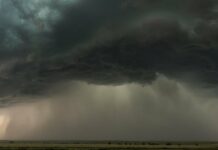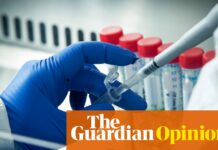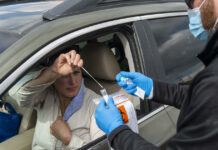According to a new study, speech can generate thousands of mini-droplets that, in a closed environment, can hang in the air for up to 14 minutes and lead to transmission of the novel coronavirus, SARS CoV-2.
The research was published this past week in The Proceedings of the National Academy of Sciences, a peer-reviewed multidisciplinary scientific journal and the official journal of the US National Academy of Sciences. According to the study, speech droplets by asymptomatic carriers “are increasingly considered to be a likely mode of disease transmission.”
Normal speaking can produce “thousands of oral fluid droplets with a broad size distribution,” wrote the American researchers.
Get The Times of Israel’s Daily Edition by email and never miss our top stories
Free Sign Up
The scientists at the National Institute of Diabetes and Digestive and Kidney Diseases and the University of Pennsylvania conducted a study where they tracked bursts of droplets produced by volunteer speakers and illuminated them using laser lights. The participants spoke through the open end cardboard box and were asked to repeat the words “stay healthy” several times to trace and measure the droplets.
“Whereas large droplets fall quickly to the ground, small droplets can dehydrate and linger as ‘droplet nuclei’ in the air, where they behave like an aerosol,” the study found, adding that they can stay in the air between eight and 14 minutes.

Two men sitting on different benches speak as they keep social distance at a seaside of Glyfada suburb, near Athens, May 15, 2020 (AP Photo/Petros Giannakouris)
The research revealed an average droplet emission rate of 1,000 per second, with up to 10,000 droplets per second depending on speech volume. Certain sounds, such as the “th” in healthy, produced more droplets than others, according to the study.
“These observations confirm that there is a substantial probability that normal speaking causes airborne virus transmission in confined environments,” the researchers wrote.
The study was conducted in a controlled environment and did not involve participants with COVID-19.
Surveys suggest Vitamin D may help
Meanwhile, a study pre-published last month by a group of researchers from Northwestern University in Illinois found a correlation between insufficient Vitamin D and the more serious effects of COVID-19.

Defying COVID-19 restrictions, Israelis enjoy the beach in Tel Aviv, as temperatures rise to 40 degrees in some parts of the country, May 16, 2020. (Miriam Alster/Flash90)
Those with severe Vitamin D deficiencies were found to suffer serious effects from COVID-19 in 17.3 percent of cases studied, while for those with normal levels the figure was 14.6%, according to the study, which has not yet been peer-reviewed.
Northwestern Prof. Vadim Backman, who led the research, estimated that eliminating vitamin D deficiency could cut the mortality rate in half.
“It will not prevent a patient from contracting the virus, but it may reduce complications and prevent death in those who are infected,” he said.
The study, which has not yet been peer-reviewed, relied on data gleaned from China, France, Germany, Italy, Iran, South Korea, Spain, Switzerland, Britain and the US. While researchers were unable to study vitamin D levels directly, they used data on C-reactive proteins from blood samples as a stand-in, noting that a correlation between the two has been found before.
Some scientists have theorized that environmental factors such as heat could affect the virus’s ability to spread, while unfounded claims on social media have led some to believe that sunlight could kill the virus.
That claim got a boost last month when a senior US official said a study had shownd sunlight could quickly destroy the virus and heat and humidity could lower the time it lives on surfaces. That study as well has yet to be evaluated independently, but US President Donald Trump spoke about it enthusiastically during a press conference.

US President Donald Trump points to the sun as he arrives to view the solar eclipse, on August 21, 2017, at the White House in Washington. (AP Photo/Andrew Harnik)
The Northwestern study does not directly link the virus to sunlight, which is a main source of Vitamin D, along with fish, eggs and milk. In general, however, having enough of the vitamin is seen as key to maintaining a healthy immune system.
The researchers found that severely low vitamin levels were more likely to trigger a so-called “cytokin storm,” in which the immune system goes into overdrive in an attempt to destroy the virus and winds up making the patient extremely ill. The cytokin storm is considered a leading factor in fatalities, though researchers have struggled to explain why it only occurs in some people, and why some countries are more badly affected than others.
The Northwestern researchers theorized that the deficiency could explain why the young, who were less likely to have developed an acquired immune system, suffered lower mortality rates.
“While I think it is important for people to know that vitamin D deficiency might play a role in mortality, we don’t need to push vitamin D on everybody,” Backman stressed. “This needs further study, and I hope our work will stimulate interest in this area. The data also may illuminate the mechanism of mortality, which, if proven, could lead to new therapeutic targets.”
Two surveys in Asia that have not undergone peer review have also pointed toward a link between vitamin D deficiency and a severe response to the coronavirus, Newsweek reported. However experts warned of the danger of the use of causal inference in that research, as well as the lack of information on research methods.
Agencies contributed to this report.






